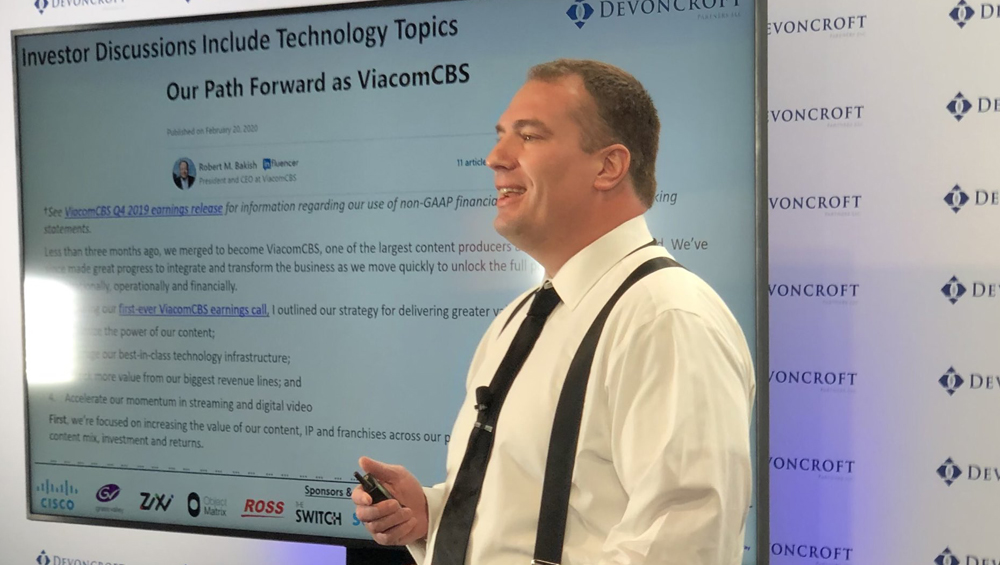
Cloud Dominates Devoncroft Discourse

Broadcasters’ growing use of public cloud technology was the biggest topic of discussion during Devoncroft Partners’ 2021 Executive Summit, along with new remote and distributed production techniques that arose out of necessity during the early days of the COVID-19 pandemic and are now becoming permanent workflows. “Virtual production” that makes use of green-screen and LED video wall technology (not to be confused with “virtualized” production, or running broadcast applications on COTS hardware) also generated buzz, while the industry’s long-touted migration to IP routing infrastructures appeared to have lost some momentum.

Joe Zaller
With the cancellation of the NAB 2021 show in Las Vegas last month due to COVID-19 concerns, Devoncroft’s conference was held virtually from the research firm’s home base of San Diego. Top executives from media technology vendors, networks and studios participated in panel-style discussions via large LCD displays, with Devoncroft founder Joe Zaller and principal analyst Josh Stinehour moderating from a studio.
Cloud Crosses ‘Chasm’
One of the Summit’s core objectives is to examine the state of the media technology industry, using Devoncroft’s annual “Big Broadcast Survey” of key broadcast customers as a magnifying glass. When asked what trends would most impact their business over the next two to three years, customers identified “multiplatform content delivery” as number one, followed by “IP networking and content delivery” and “remote production (REMI).” “Cloud computing/virtualization” ranked only fifth, behind “artificial intelligence/machine learning.” But Stinehour said cloud’s lower-than-expected ranking was misleading.
“That’s just because it’s not new anymore,” Stinehour said. “We’re starting to do that.”
In fact, Stinehour said that the cloud has already crossed the “chasm” that all new technologies face before gaining wide acceptance. The Summit certainly bore that out with discussions of successful cloud implementations at several major media operators including Discovery, A&E Networks, ABS/CBN and Sky.

Josh Stinehour
In touting the cloud’s benefits, Stinehour pointed to a recent case study from Amazon Web Services of early cloud adopter Discovery, which began moving playout to the public cloud back in 2015-16. According to AWS, Discovery experienced a 13-times increase in staff productivity and a 37% decrease in time to market by taking its playout from traditional hardware to the AWS cloud.
Stinehour noted that when broadcasters first adopt the cloud their spending generally starts small, with a few experiments. They move onto some initial workflows, spending a bit more, before putting a “meaningful workflow that’s complex” in the cloud and significantly increasing their spend. At some point, key management is convinced of the cloud’s merits and “now you’re pushing on an open door” with a big release in dollars.
Looking broadly, he said that time is drawing near for the industry as a whole. (Though most Summit speakers said full live production in the cloud is still probably five to seven years away.)
“This is the swooshing sound, this is going to happen,” he said. “The data is telling us that we are right at a huge influx of dollars going into the cloud.”
Trouble For Legacy Vendors?
Beyond cloud platforms like AWS, Microsoft Azure and Google Cloud, many of those dollars will also likely be going to new software-based “cloud native” vendors instead of traditional broadcast suppliers who are attempting to transform their current products into software that can run on the cloud. Sky has 30 channels playing out from the cloud today and is looking to move all of its channels there by the end of 2022, as part of a broader migration of its content supply chain. But as it does so, it is avoiding working with legacy vendors, said David Travis, group director of content, broadcast and platforms for Sky.

David Travis
“Working with vendors who are trying to take the traditional monolith and transition it to the cloud has proven in my experience to be extremely painful and gets you into very murky waters,” Travis said. “Because you end up with an architecture that doesn’t benefit the true benefits of cloud-native — it’s not microservices. If it’s not cloud native, we’re not interested, We would rather run the risk of roadmap development of features, rather than architecturally replatforming.”
One cloud-native vendor gaining traction is Amagi, whose CEO and co-founder Baskar Subramanian described how A&E Networks shifted its U.K. playout operations from a traditional data center to the AWS cloud in eight weeks using Amagi’s software.
A&E Networks UK is now delivering 30 channels to 100 million pay TV subscribers across Europe with operators able to work remotely from home, which Subramanian called “a big case study for how we could do completely remote playout and actually be able to manage it flawlessly, without having to have on-prem infrastructure.”
Philippine broadcaster and programmer ABS/CBN also turned to Amagi after unsuccessfully trying to move to cloud playout using software from a legacy vendor. Rab Mukraj, CTO for ABS/CBN, said that Amagi’s software didn’t cover all of his requirements in an initial proof-of-concept (POC), perhaps 95%. But he was impressed by the speed at which Amagi could create new iterations of software based on his needs.
“The velocity at which they move and how they adapt is noticeably different than the traditional vendors,” Mukraj said.
Labor Crisis
Just as the 2011 tsunami and earthquake in Japan that destroyed Sony’s tape factory hastened the industry’s move to file-based workflows, COVID-19 has accelerated the industry’s move to the cloud and jump-started remote production workflows for sports and news that many broadcasters were already experimenting with before 2020. But the pandemic has also brought significant upheaval to the labor market, particularly among the freelancers who work major sports and entertainment events. Stinehour called it a “looming HR crisis” and cited a survey from staffing firm Program Productions that indicates that 30% of its technicians may be leaving the industry for good.

Mike Davies
Mike Davies, SVP, technical and field operations for Fox Sports, said that labor availability — particularly specialized engineers — is a big focus for him.
“Because all these things we’re talking about in terms of IP engineering require people who know what they’re doing, computer scientists who are able to understand this,” Davies said. “The business of broadcast has changed. Also, simply operators. There are people that say that we’ve lost 15%, 20%, even 30% of operators out there due to the pandemic and losing things like visiting feeds and other types of shoulder programming. That’s one thing I’m particularly concerned about.”
Supply Chain Problems
The continued impact of the pandemic on global supply chains was also cited by both vendors and customers as a threat to the pace of technology innovation. Dave Sampson, CEO of AJA Video Systems, said that sales for his company took off during Q3 and Q4 2020 but that shipments slowed in 2021 as the manufacturer of converters, frame synchronizers and other modular products had difficulty sourcing components. In some cases, that led to international orders sitting on a pallet with 49 out of 50 ordered products ready to go but one still waiting on a key component.
“We’ve got this awful perfect storm of exploding sales and lack of parts,” Sampson said. “We’re very privileged that we can spend money and have a lot of inventory, and we did, but at some point, you run out. When you can’t get parts, you can’t fulfill the orders.”
Telestream CEO Dan Castles said his company’s products, such as its popular transcoders, are mostly software but some do run on standard servers that Telestream procures for customers. To avoid a server shortage, Telestream had to “bet big” and bought a half-year supply, which worked well. But Castles said his company had run into similar component shortages as AJA for some monitoring and measurement products and was facing pressure from customers who are looking to spend “year-end money” to deliver products this calendar year, not in January or February 2022.

Christian Kennel
Christian Kennel, VP production and post technology at Fox Entertainment, said supply chain problems are the “number-one issue” he is keeping track of as the Fox studio creates a new cloud-based technical infrastructure in the wake of the Disney/Fox merger. Kennel said Fox had ordered 80 high-end HP Z8 workstations and had to wait seven months to get them and was facing similar issues with networking gear and discreet components like audio mixers.
“It doesn’t just affect us, it affects all the cloud providers,” Kennel said. “If you want to unlock new workflows, you’re going to need tools.”
IP Routing Loses Steam
While previous Summits detailed significant new investments in SMPTE 2110-compliant IP routing, the dialogue around IP was much more muted this time. Mobile vendor Dome Productions built its first all-IP, UHD-capable truck in 2020, but Dome SVP and GM Mary Ellen Carlyle said the company is holding off on building another IP truck even though it retired two mobile units this year.

Mary Ellen Carlyle
“It’s not there yet,” Carlyle said of IP routing. She said there wasn’t a true 4K workflow for Dome due to interoperability issues between Grass Valley IP routers and Sony IP cameras. As an interim move, the company is instead building a Sprinter-based unit called Wavelength with a Ku-band uplink and a bevy of IP transmission options like 5G, SRT and low-earth orbit (LEO) satellite.
AJA thought 2110 adoption would be further along by now, Sampson said. His company jumped into IP routing early but then saw the technology lag due to the complexity of implementation and fighting between standards.
“It’s been anything but smooth,” Sampson said. “Everybody wants a way from 3-gig, 12-gig, the standard baseband. But it doesn’t seem as though 2110, or the 2022-6 or 2022-7, any of those flavors, have really arrived as they were promised. When you talk about IP, you’ve got your 2110 proper, then you’ve got the ‘IP lites’ like NDI and Dante, and we’ve seen a lot of uptick in those formats. But the pure, hard-core 2110 is still in process.”
Fox Sports was an early convert to IP routing in the mobile trucks it uses to produce big events, and Davies said the technology is key to the centralized production techniques it employs today. But he also declared that there is still work to do.
“We’re in a conundrum a little bit,” Davies said. “IP routing is essential for today’s business, there’s no way around it. With everything we’re being asked to do and achieve on the network side, and I would presume on the vendor side, IP technology is simply essential.
“However, it’s not done yet,” he said. “I wouldn’t call it immature — I would say that it’s evolving. Basically, it’s the tenet that whatever you buy today, whatever that box is or whatever that rack of stuff is, it’s not going to be the same thing tomorrow. And there’s a certain degree of faith you have, that whatever you buy today will be better and meet your needs better tomorrow.”
































Comments (0)